Dog Begging For Food? Here’s How To Stop It For Good
While pretty cute, a dog begging for food can be annoying at best - and life-threatening at worst, especially if they eat everything offered to them! So here's why they do it, what you can do to stop it & how to plan ahead for an emergency.
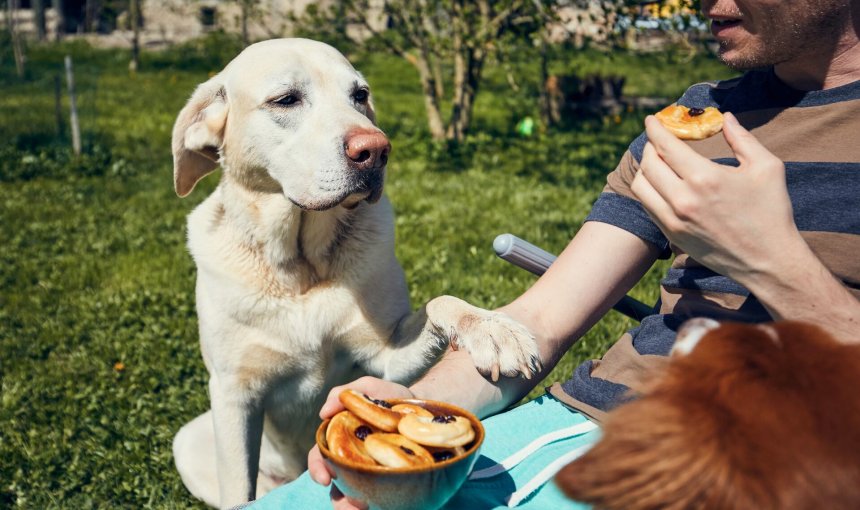
It can be pretty cute watching your dog begging for food – but let’s admit it, it can get annoying after a while too!
Because like it or not, every extra little bite, lick, and taste your buddy gets their paws on can end up with them:
- Eating something potentially being something toxic – or just off-limits for them
- Likely to grow overweight with time, if left unattended
- Likely to end up in some dangerous situations outdoors, if your food-motivated dog likes to wander off looking for some extra “treats”
So here we’re going to cover why dogs might end up begging for food and extra treats – even if you’ve fed them – plus, what you can do to wean them off this behavior. (Including figuring out their favorite hangout spots around town, where they might be hiding their snack stash.)

Find out how your dog spends their time.
Read more- Why is my dog begging for food? I JUST fed them!
- How to stop your dog from begging for food & treats
- Follow a consistent feeding schedule
- Ignore the begging
- Set some firm boundaries with your friends, family & housemates
- Never let your dog into the kitchen or dining areas unsupervised
- Keep your dog occupied elsewhere while cooking
- Don’t skip out on your dog’s training
- Keep your buddy well-exercised
- Keep an eye on your dog’s outdoor wanderings
- Read to set your buddy up for a healthy, snack-free life?
Why is my dog begging for food? I JUST fed them!
And we totally get it! It can be annoying when you’ve gotten your buddy their high-quality dog food, set out their food bowls, had a proper mealtime…and now your dog’s using the puppy eyes on Grandma for some extra snacks.
So it’s important to figure out why dogs beg for for food in the first place. Primarily, it’s a learned behavior – meaning, it’s gotten them a good outcome (aka, treats) in the past. So they’re likely to repeat it as much as they can get away with it.
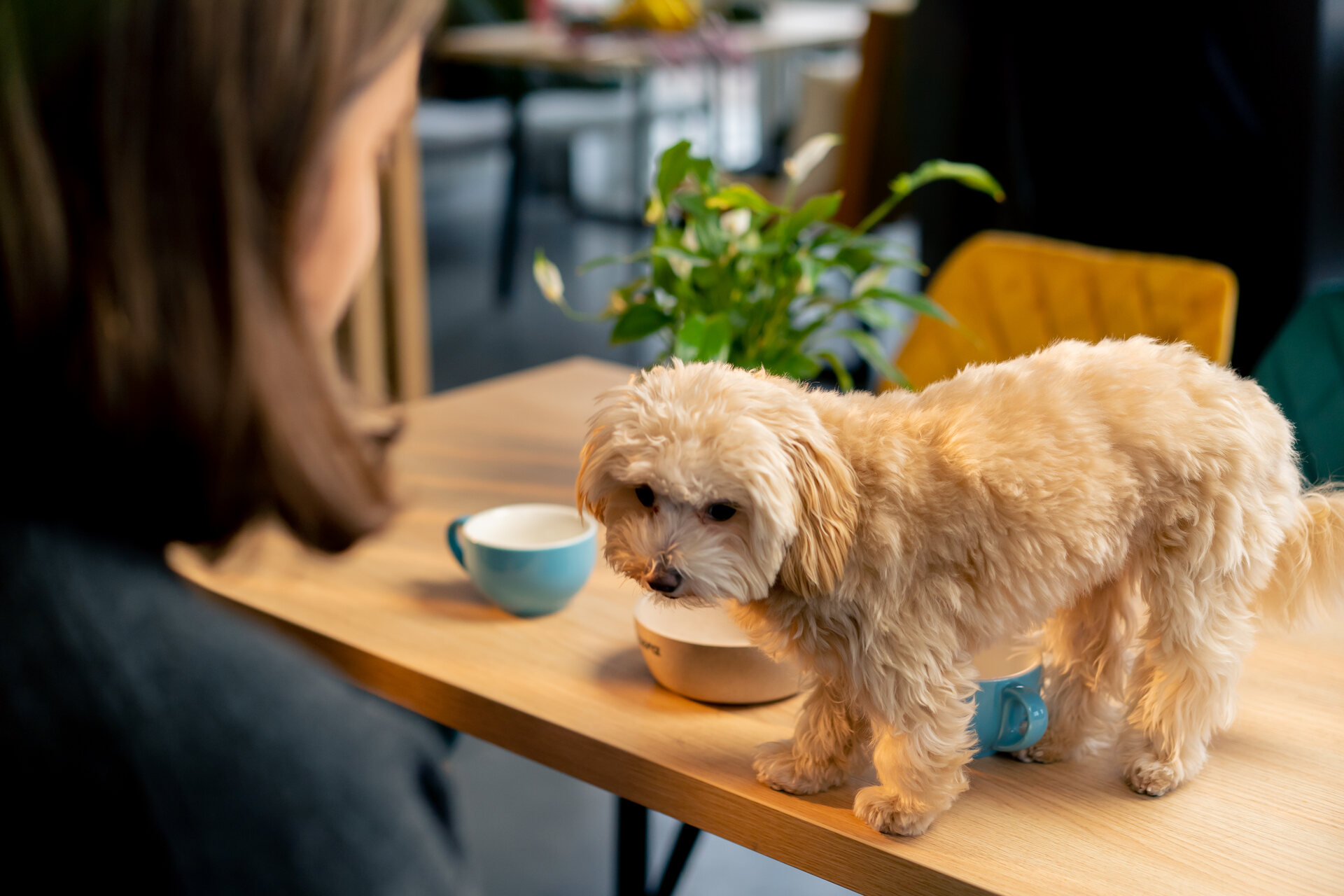
Besides, you might also see your dog begging for food as a form of…
- Attention-seeking, especially if extra treats also mean extra pats, praise, and affection
- Boredom, which might also manifest as other forms of mischief – especially if they have a ton of energy to burn!
And in some (arguably rarer) cases…
- Actually still being hungry
So here are some steps you can take to wean your buddy off begging – which can help you figure out why they’re doing it in the first place.
How to stop your dog from begging for food & treats
It might break your heart – but training your dog to modify their behavior takes nerves of steel. (Especially when it comes to saying “No.”)
So first things first, make sure to:
Follow a consistent feeding schedule
And stick to it. Dogs thrive on routine and feeding them around the same time every day can help them figure out when it’s mealtime. If you’re consistent, it can gradually reduce their urge to beg outside of these times.
Your vet can help you figure out the right amount of food your buddy needs depending on their:
- Age
- Size
- Breed
- Activity level
- And any other health-related factors to keep in mind
In general, most dogs do well with two sensibly-portioned meals a day – one in the morning and one in the evening. And as the weather gets warmer, it helps to ensure they’ve got access to plenty of cool water throughout the day.
Read more: How much should I feed my dog and how often?
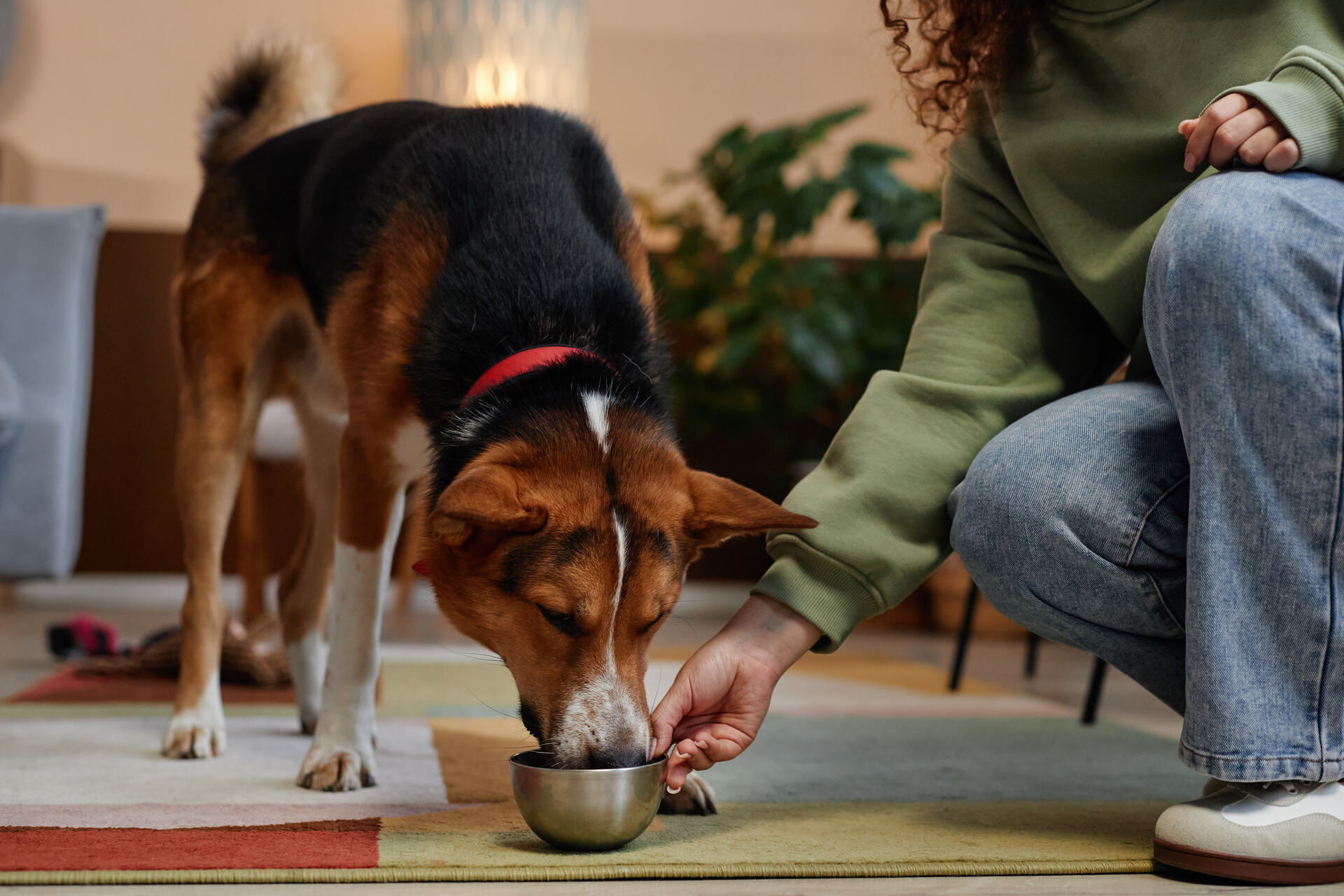
⚠️ We also strongly recommend you avoid free-feeding – i.e., don’t leave food out all day for your dog to freely access.
- Unless you’re there to teach them, most dogs aren’t picky eaters and some might have zero to no limits around unrestricted amounts of food!
- With time, this can lead to overeating, obesity, and a host of throughly avoidable – and even deadly – health problems.
So once you’ve set up your buddy’s feeding schedule, here are a couple of steps to put a stop to their begging – for good.
Read more: What Makes Dogs Fat? Getting An Overweight Dog Back In Shape
Ignore the begging
Yes, we get it – this is the most difficult step of them all. But with some practice and consistency, you can help your dog learn that no amount of whining, crying, or puppy eyes means extra treats.
So if you’ve got your dog begging for food, you have to practice not giving them any attention.
- Avoid making eye contact or talking to them.
- You could even physically turn away from your dog when they beg.
- More begging? Leave the room until they stop.
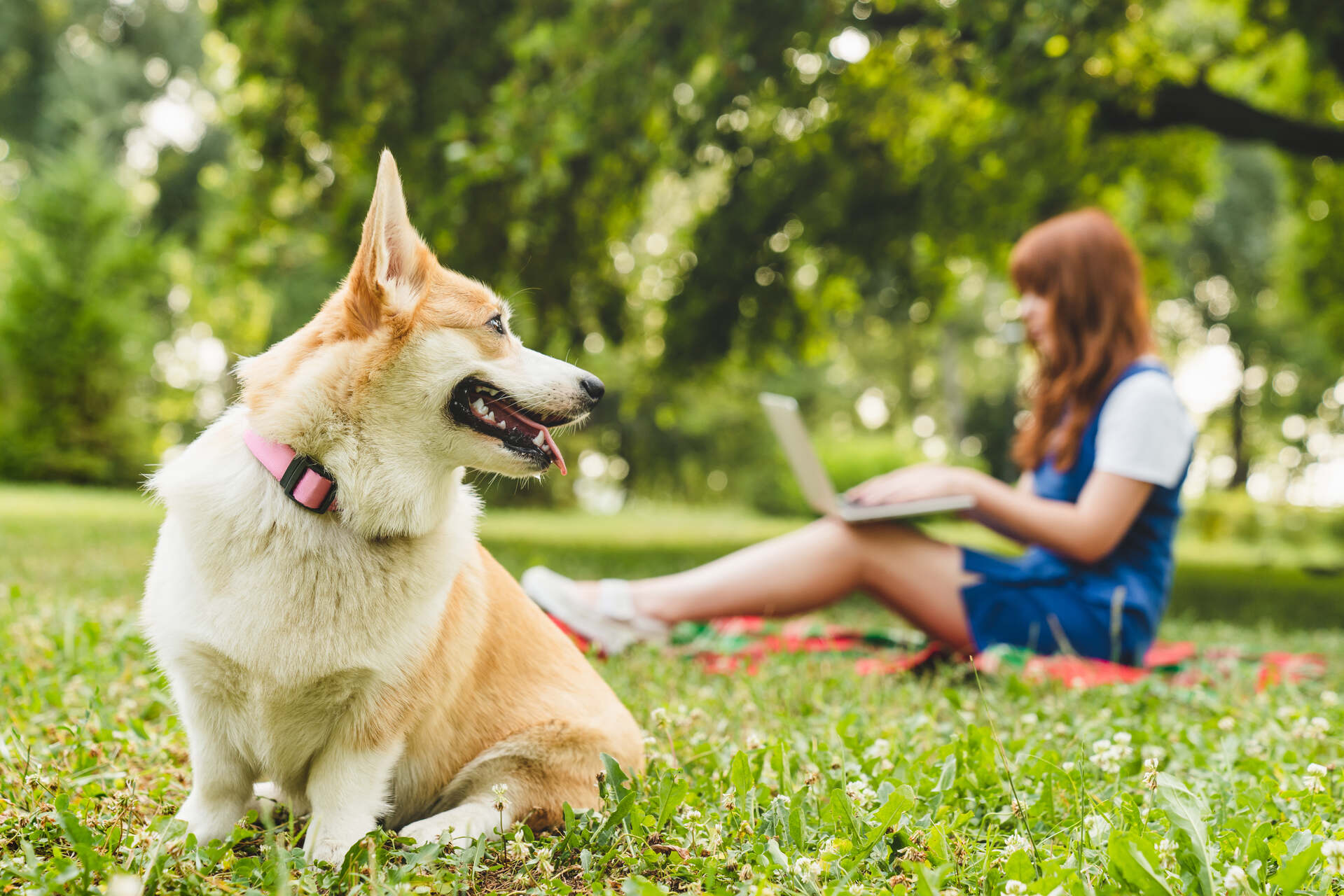
As counterintuitive as it is, interacting with or speaking to your dog in any way (“No, I can’t give you more – you just ate!”) just means you’re giving them attention. Which, unfortunately, means your buddy will persist with the puppy eyes or making a nuisance of themselves until you give in.
💡But by ignoring them, you can help your dog learn that “begging for food = no attention or treats.” So make sure you’re consistent – even the slightest bit of attention can get your buddy back to begging again!
Set some firm boundaries with your friends, family & housemates
Now your dog is smart enough to sniff out any loopholes in the “no attention when begging” policy. Meaning, easy targets around the house – like your mom, Grandma, your kids, or anyone who finds it difficult to say “No!”
⚠️ So it’s crucial to have everyone in your household on the same page regarding your buddy’s feeding schedule.
You could always have a situation where one of your kids palms off some unwanted veggies to your buddy – or someone feeds them something potentially toxic, entirely by accident. (And now you’re both in the emergency vet ward.)
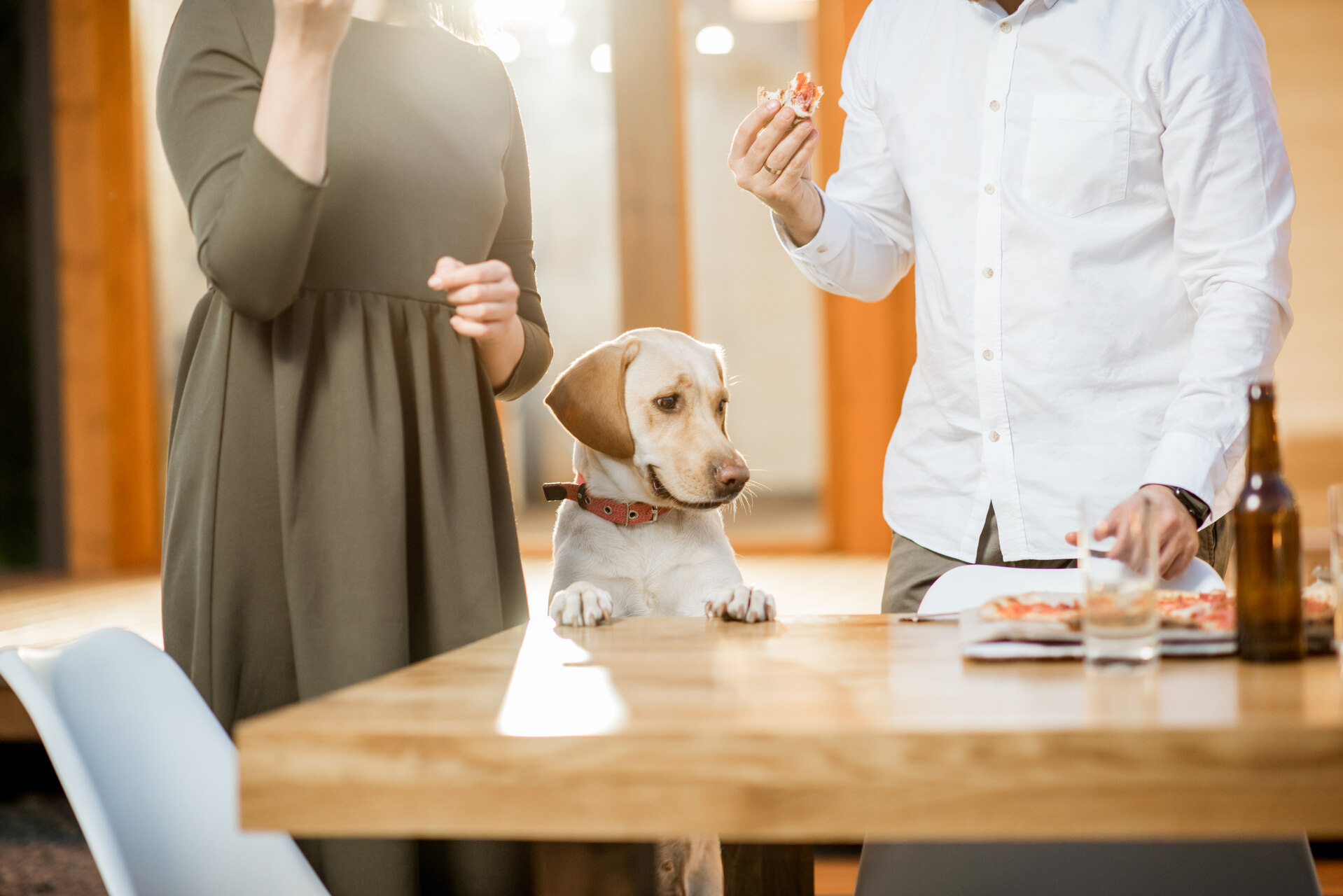
So make sure to:
- Explain why it’s important not to feed your buddy any table scraps or treats outside of their designated feeding times.
- Gently remind guests and family members of the rules when necessary. You could even put up signs around your house as reminders of your “no extra treats” policy.
- Besides your housemates, it’s smart to inform your neighbors as well. (In case your buddy has a habit of wandering over to their backyards or around your neighborhood.)
- Suggest alternatives, like playing with toys or giving your dog a ton of pets and praise (without food being involved.) Your guests still want to interact with your dog without feeling too guilty!
- Keep some healthy treats at hand, like fresh vegetables that are safe for dogs to eat or some low-calorie kibble.
Read more: 10 Of The Best Vegetables For Dogs & How To Prep Them
Never let your dog into the kitchen or dining areas unsupervised
Besides begging, there’s always the chance your buddy might sneak a bite or two off your kitchen counter – or anything that might drop on the floor from the table.
Meaning it’s a good idea to monitor every morsel that ends up in their mouth, especially if you’re busy in the kitchen.
Because in some cases, it’s an annoyance at best – like if they eat something harmless. But in other cases, many ingredients that are harmless (and even healthy) for humans might just end up being toxic to dogs. (And land you with a hefty, thoroughly avoidable vet bill.)
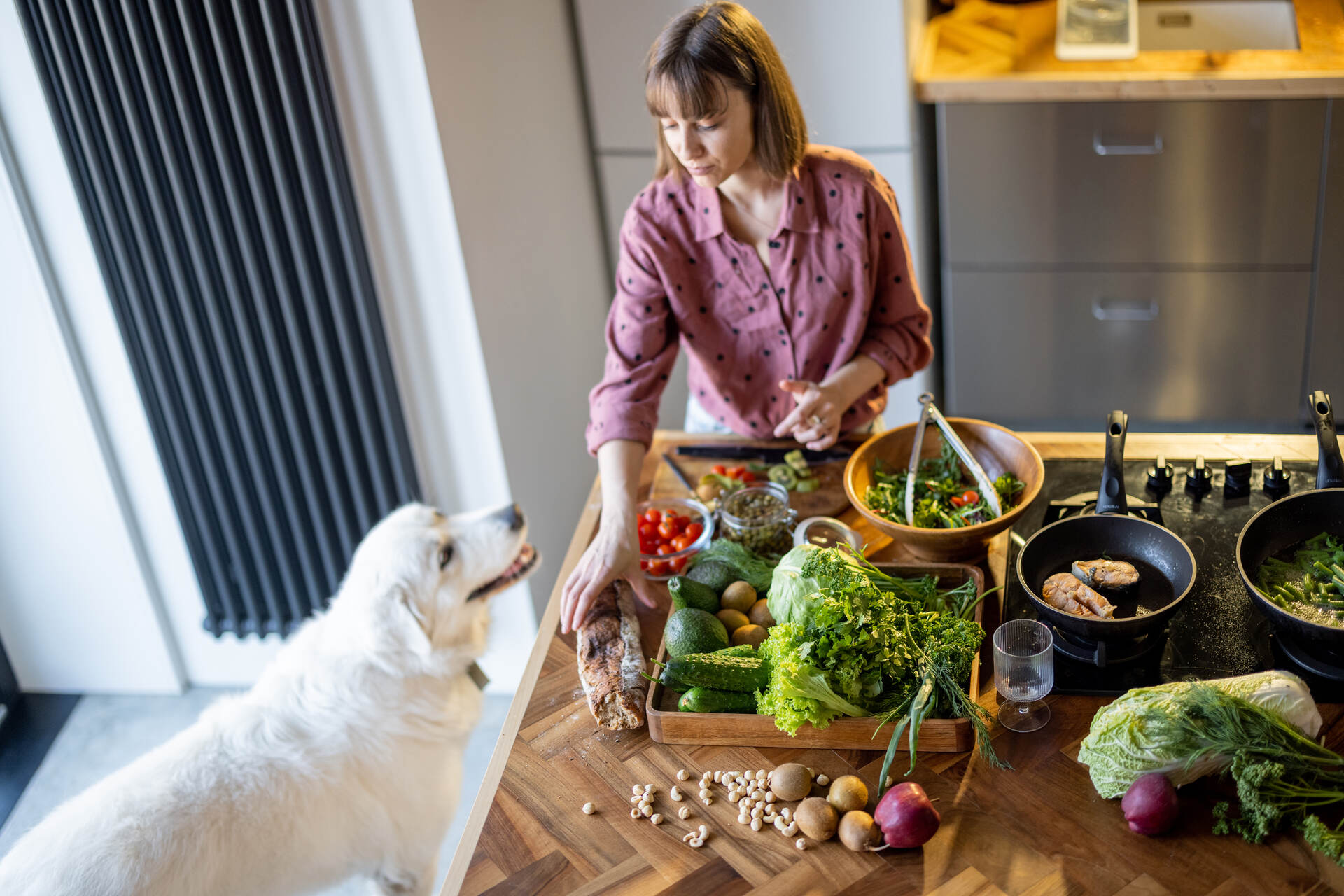
💡 So stay informed on what common kitchen ingredients are off-limits for dogs – and make sure to keep your buddy well away from these.
For example, besides chocolate, dogs can also be poisoned by:
- Onions
- Garlic
- Grapes
- Raisins
- Mushrooms
- …and a host of other foods.
Read more: What Can Dogs Not Eat? 15 Foods Poisonous To Dogs
Keep your dog occupied elsewhere while cooking
Besides supervising your buddy in the kitchen, we’d also recommend you create a separate feeding area for them.
- The physical separation can help reduce their temptation to beg at the “human food” table.
- Make sure this are is quiet and free from distractions – and that you’re feeding your buddy at regular times.
It’s also not a bad idea to keep your dog distracted while you’re busy with meal prep. Give them a puzzle toy to keep them occupied – or get one of your housemates (or kids) to play with them while you’re cooking.
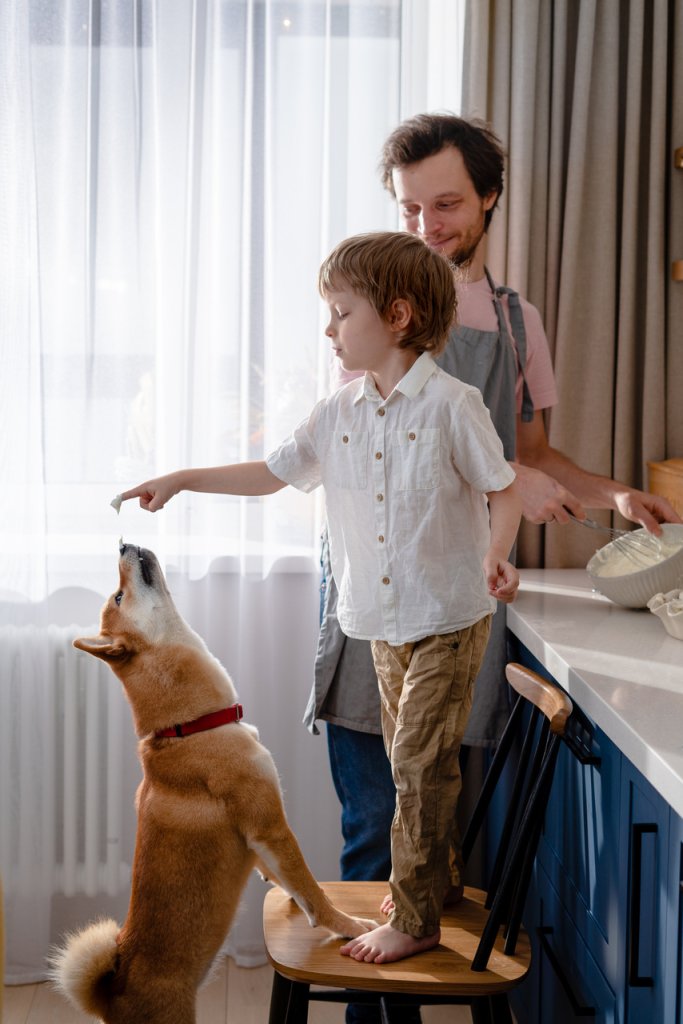
💡YouTube has a ton of 8-10 hour video streams meant to keep dogs entertained. Just watch out your buddy doesn’t leap at your TV screen after a squirrel or bird on video!
Don’t skip out on your dog’s training
While there’s no substitute for daily training, it’s even more crucial when you’ve got a food-motivated dog at home. Teaching your dog commands like “Sit,” “Stay,” and “Drop it,” can help them learn to control their impulses and not go running behind every morsel like it’s their last meal on the planet!
This might look like training your buddy to:
- Sit while you get out the food bowls,
- Stay for a few seconds after you’ve poured out the food
- Drop it, if they immediately dive into eating – or pick up a “treat” that’s fallen from the kitchen counter
- Only eat once you give the command “Eat,” – or similar
Read more: 4 Important Dog Commands & How To Teach ‘Em
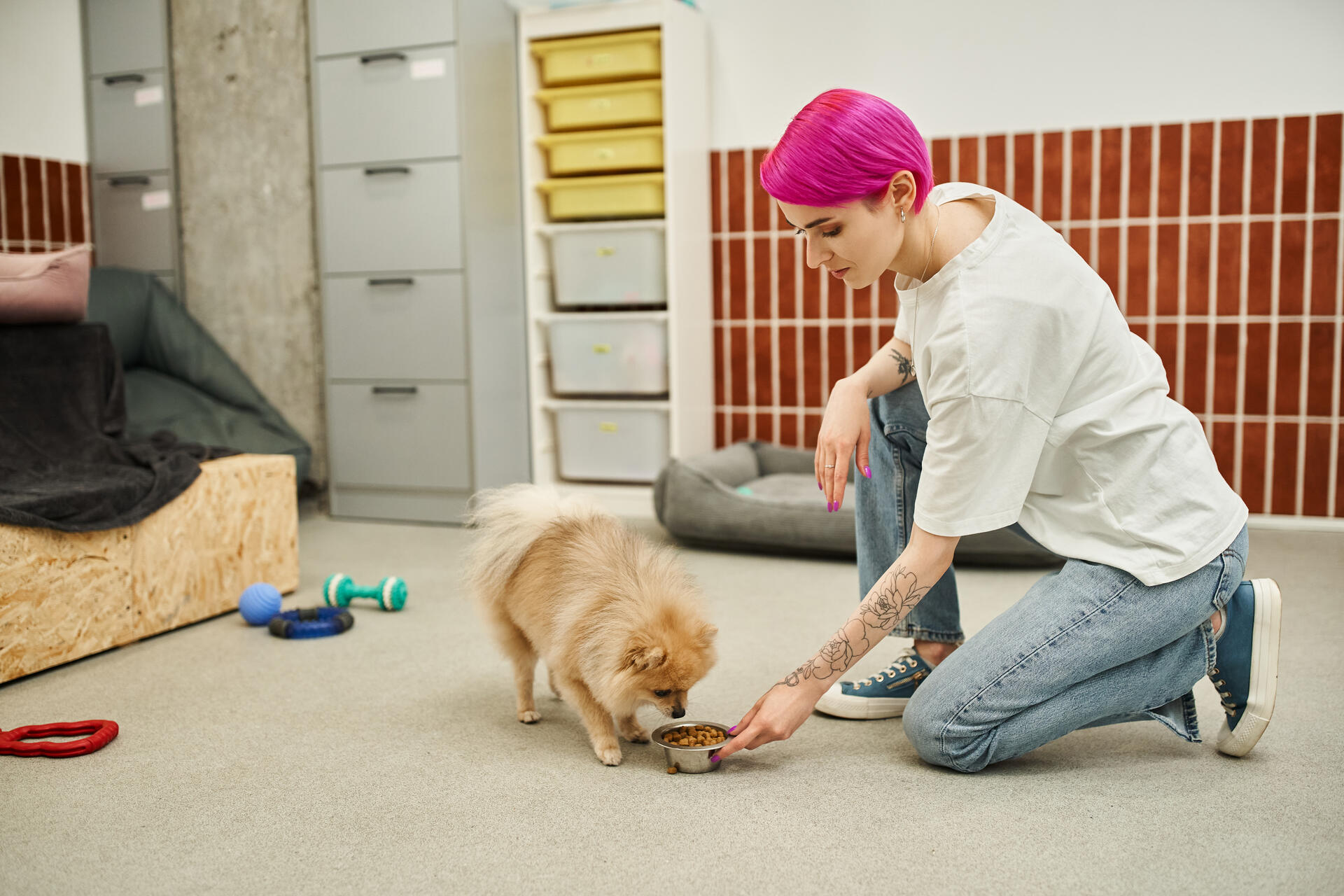
💡So if you’ve been skipping out on training these commands, it helps to revisit them periodically to keep your buddy’s memory fresh.
- Regular training can also help prevent your dog from getting bored – one of the key reasons they end up begging around mealtimes.
- Make sure to reward your buddy with a ton of praise when they DO behave around mealtimes. So they learn “no begging = reward.”
- Try and avoid using treats as a reward, if possible. If you’ve got a food-motivated dog, you want to ensure they also learn to associate “reward” with pets, praise, and attention. (Which is another reason you might have a dog begging for food at home.)
- Keep your training sessions short – and be consistent. The long-term benefits of your dog not making a nuisance of themselves around mealtimes are 100% worth it.
Keep your buddy well-exercised
Besides regular training which keeps your dog mentally active, daily exercise can help get your buddy the activity they need to prevent any boredom or need for attention-seeking. Plus in general, experts recommend at least 30 minutes of daily activity for adult dogs.
Which could look like:
- Daily walks, 1-2 per day at different times as your schedule permits
- Regular playtime, including with toys like balls, frisbees, or even a tug rope
- Plenty of interactive toys and puzzles to keep your buddy occupied at home when you’re not around
- A DIY indoor or outdoor obstacle course, using some pillows, cushions, chairs, and even broomsticks for your buddy to jump over.
- Indoor games for a rainy day, including hide and seek, climbing up and down staircases, or a scavenger hunt for toys.
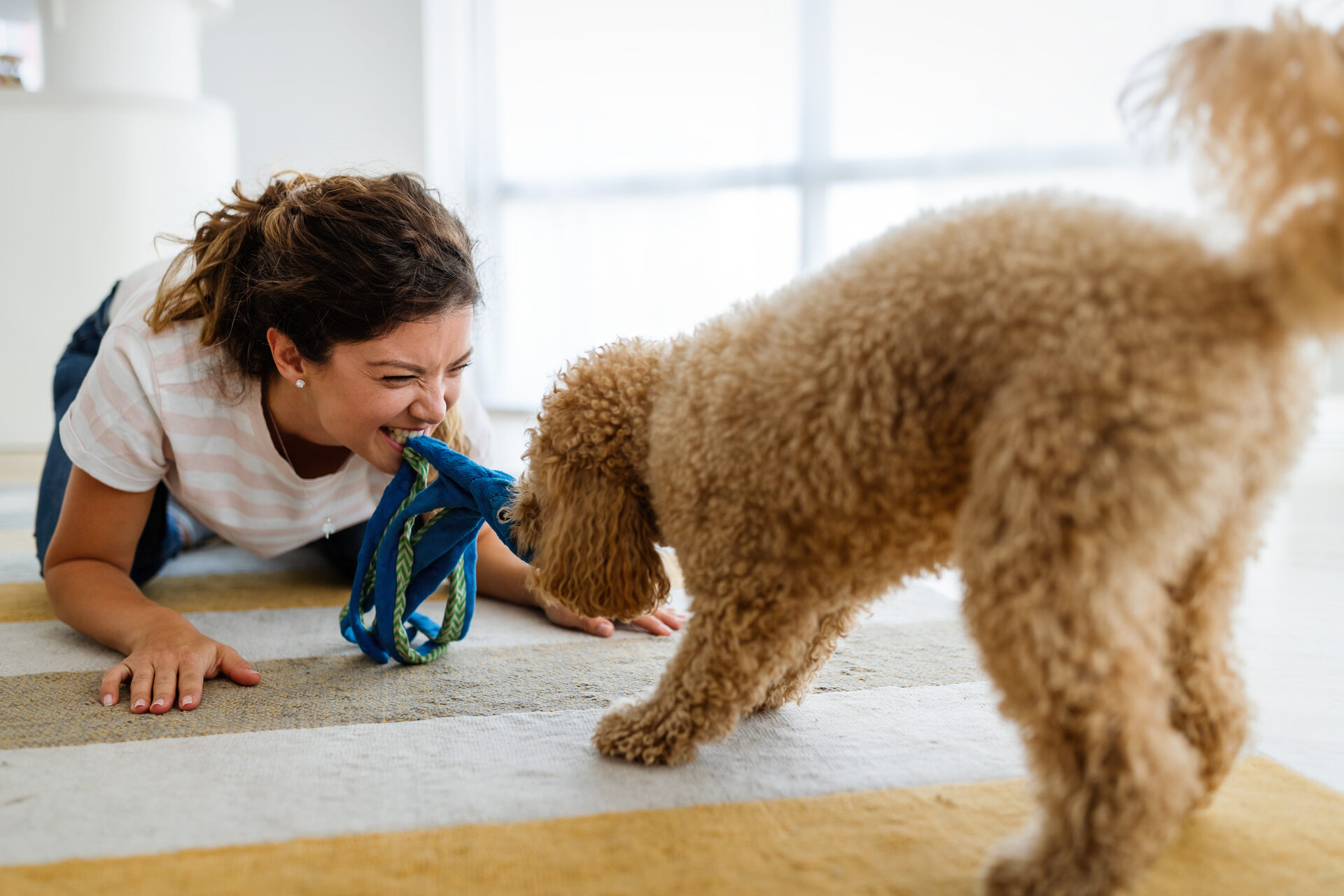
💡 And a great way to stay motivated to your buddy’s exercise routine? Checking off their daily activity goals – and comparing how active they are to other, similar dogs around the world.
Both of which you can do with your very own Activity Tracker for dogs.
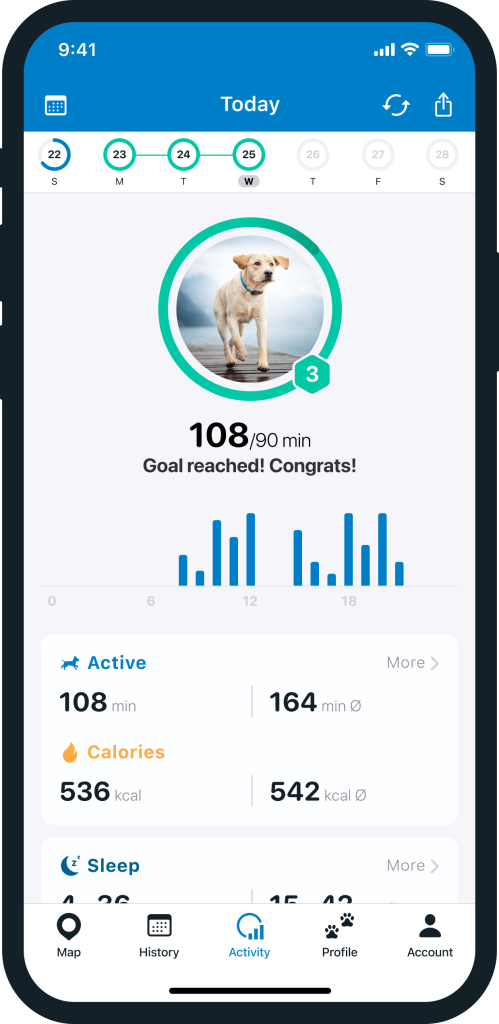
With its built-in motion detector, your trusty Tractive device logs in your dog’s movements and active minutes throughout the day.
Which, with time can help you figure out:
- If your dog’s hit their daily activity goals
- Whether your dog’s gotten enough exercise – or can afford some more playtime
- How active other, similar dogs around the world are compared to yours with your very own community leaderboard
All of which can help you stay motivated, accountable, and take an active role in your buddy’s health and well-being.
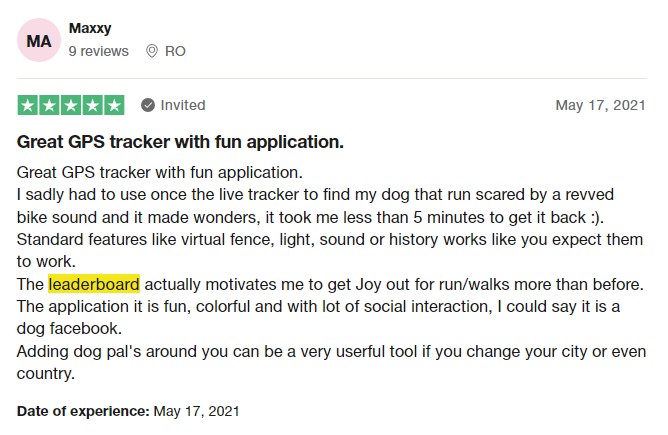
Keep an eye on your dog’s outdoor wanderings
Even with all these precautions, some dogs can still wander outdoors to sniff out some extra treats or snacks – sometimes too far away from safety.
Meaning, if you don’t take steps to plan ahead for an emergency, you’re likely to find your dog begging for food and making a nuisance of themselves at:
- Picnics at your local park
- Camps in any woodland areas nearby
- Dog parks in your neighborhood
- Outside cafes and restaurants
⚠️ And a host of other places someone might feed them something harmful – whether by accident or not.
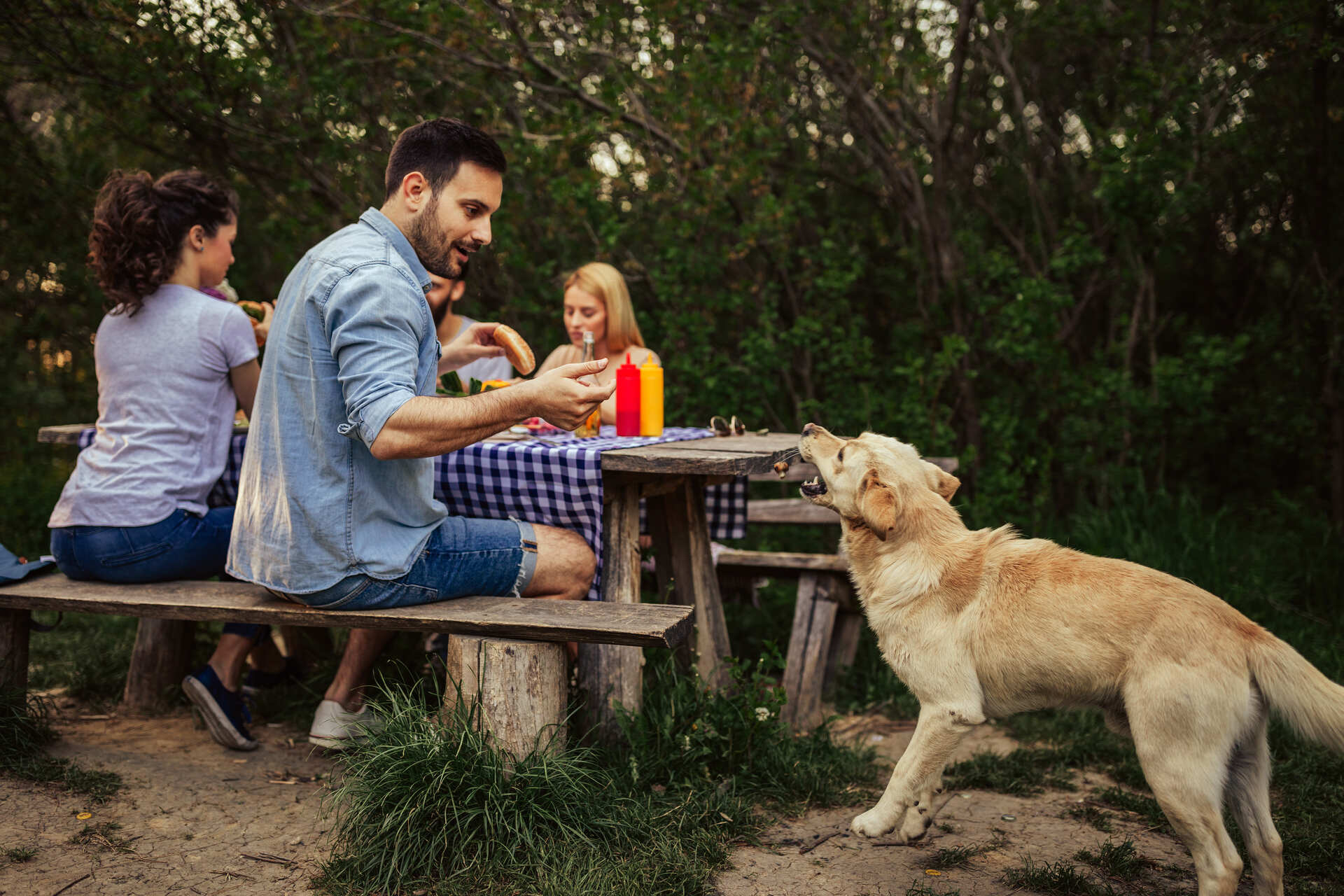
In times like these, here are some steps you can take to keep your free-range buddy safe.
- Ensure they’re easy to identify, with a dog ID tag and collar with your contact details. (Ideally, one that also includes a note like “Do not feed!”)
- Inform your neighbors so they can either help you physically search for your dog, in case they get lost – or alert you if they spot them in your neighborhood.
- Get your buddy microchipped. A vet can implant one in under 10 minutes between your dog’s shoulder blades – meaning they now have a permanent ID tag that contains your contact details. It’s a painless, relatively affordable process that might also be a legal requirement depending on your state or country.
⚠️ Just remember: ID tags and microchips can only help others identify your dog. Not track them in real-time or help you figure out where they’re off wandering – or how to find them in the first place.
💡That’s where a GPS tracker can be a lifesaver instead.
Meaning you now have a sky full of satellites helping you track your dog’s movements – as they make these movements.
And besides Activity Tracking, strapping your trusty Tractive device to your buddy’s collar can help you:
- Track your dog in real-time – over an unlimited range
- Set up a “safe zone” around your home or backyard – and get an escape alert if your dog tries sneaking past it
- Figure out your dog’s favorite hangout spots around town – and mark them as danger zones, if necessary

Pictured here is your buddy’s Heat Map and Location History – which can help you understand where your dog likes to spend most of their time.
Which could be:
- The local trash disposal
- Your neighbors’ – who aren’t aware what foods are off-limits for dogs
- The manure-strewn farm nearby
- …or anywhere they could eat something harmful or come in contact with toxic, poisonous, or infectious substances
And once you’ve figured out where your dog likes to hang out best, you can even mark them as danger zones, if you notice harmful substances like poison bait, toxic plants, wild animals, or even sharp objects.
Here’s how you can do it on your Tractive app:
💡And the best part? Your danger report gets broadcasted to other Tractive dog parents around you.
Helping you both keep your buddy safe – and do your part as as responsible pet parent.
Read to set your buddy up for a healthy, snack-free life?
Ignoring your dog begging for food can be a difficult step – but it’s how you set them up for a healthier, happier life by your side, over the long run. All it takes from your side is consistency, training, and setting some clear boundaries.
- Follow a consistent feeding schedule to help your dog develop a sense of routine and predictability. Your vet can help you figure out how much and how often to feed your buddy around these times.
- Ignore any begging behavior. We get it – this can be tough! But it’s also one of the most effective ways of weaning your buddy off any demands for extra treats and snacks.
- Set some firm boundaries with friends, family, guests, and other housemates. If everyone’s on the same page, it’ll be easier reducing your dog’s begging behavior with time.
- Never allow your dog into the kitchen or dining areas unsupervised. Common kitchen ingredients like onions can be toxic to them and lead to you both having to visit the emergency vet ward.
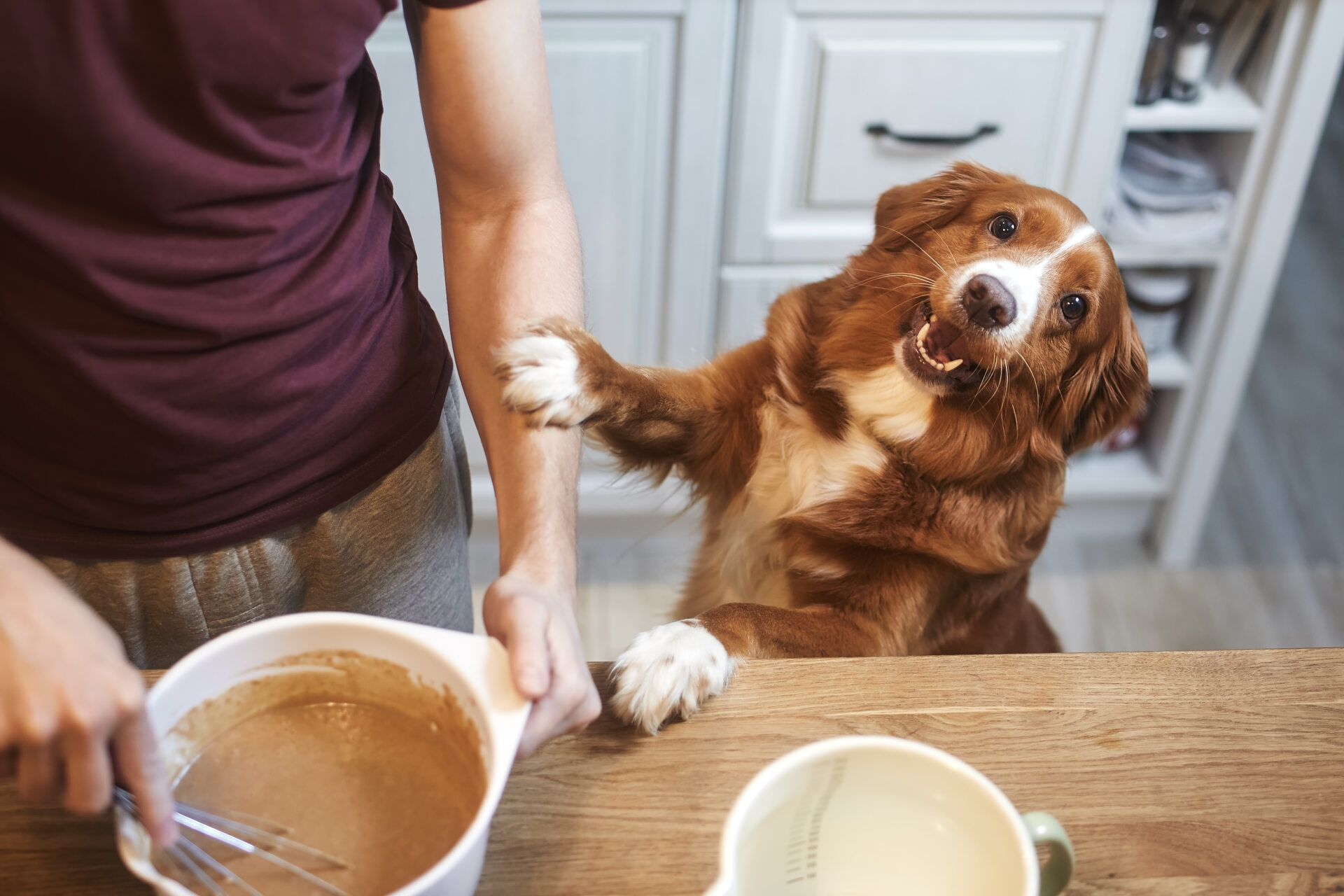
- Keep your dog occupied while cooking with a toy, someone playing with them, or even a YouTube video, if you find one that won’t get your buddy attacking the TV screen. A separate feeding area from the “human food” table can work wonders too.
- Don’t skip on your dog’s training, especially commands like “Sit,” “Stay,” and “Drop it” during meal times.
- Keep your dog well-exercised to prevent any boredom. Plus, the quality time this gives you mean they’ll be less likely to beg for food out of attention-seeking.
And in the worst case scenario…
- Plan ahead for an emergency – especially if you have a food-motivated dog that might end up wandering outdoors for some extra snacks.
💡Which, if you’ve invested in a Tractive device, has never been easier to do.
Because with just a glance at your phone, you can both track your dog in real-time – no matter how far they wander – and also figure out their favorite “food-hunting” spots around town.
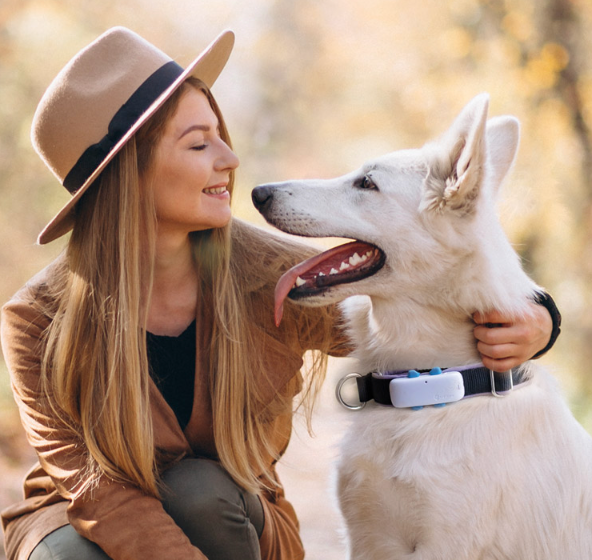
Helping you both:
- Prevent your buddy from wandering too far from safety
- …and potentially eating something that’ll land them at the vet’s clinic.
And most importantly…
- Save a ton of time, effort, money, and sanity you might’ve otherwise lost finding your dog, dealing with them being sick all over your house – and then dealing with the vet bill.
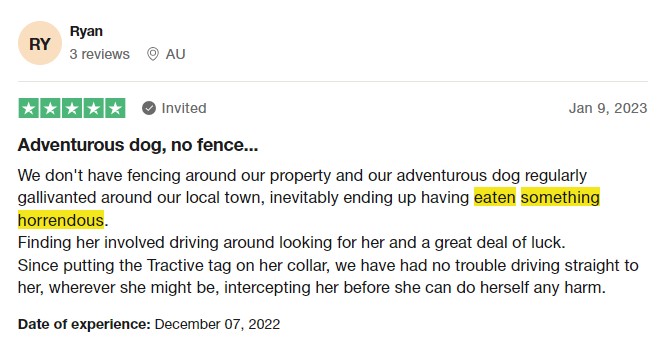
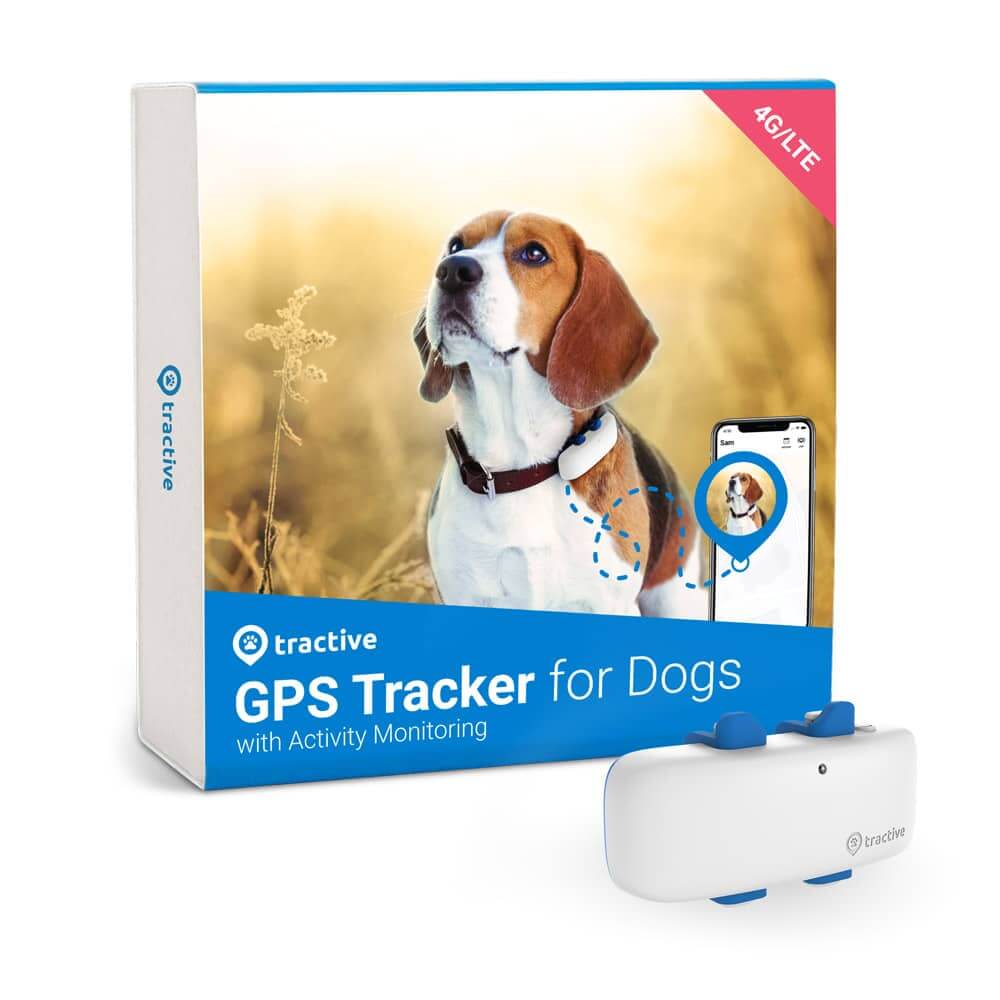
Always know where your dog is
Follow every step in real-time with unlimited range. Get alerts if they wander too far. Keep them happy & healthy with Wellness Monitoring. And let others – like walkers or sitters – keep an eye on your dog too.
Want to see the experts putting their anti-dog begging tricks in action? Here’s how they do it at the Battersea Dog and Cats Home:
And if you’ve liked this post, share it with a friend or a loved one – and let’s help build a safer, kinder world for our furry friends together.




